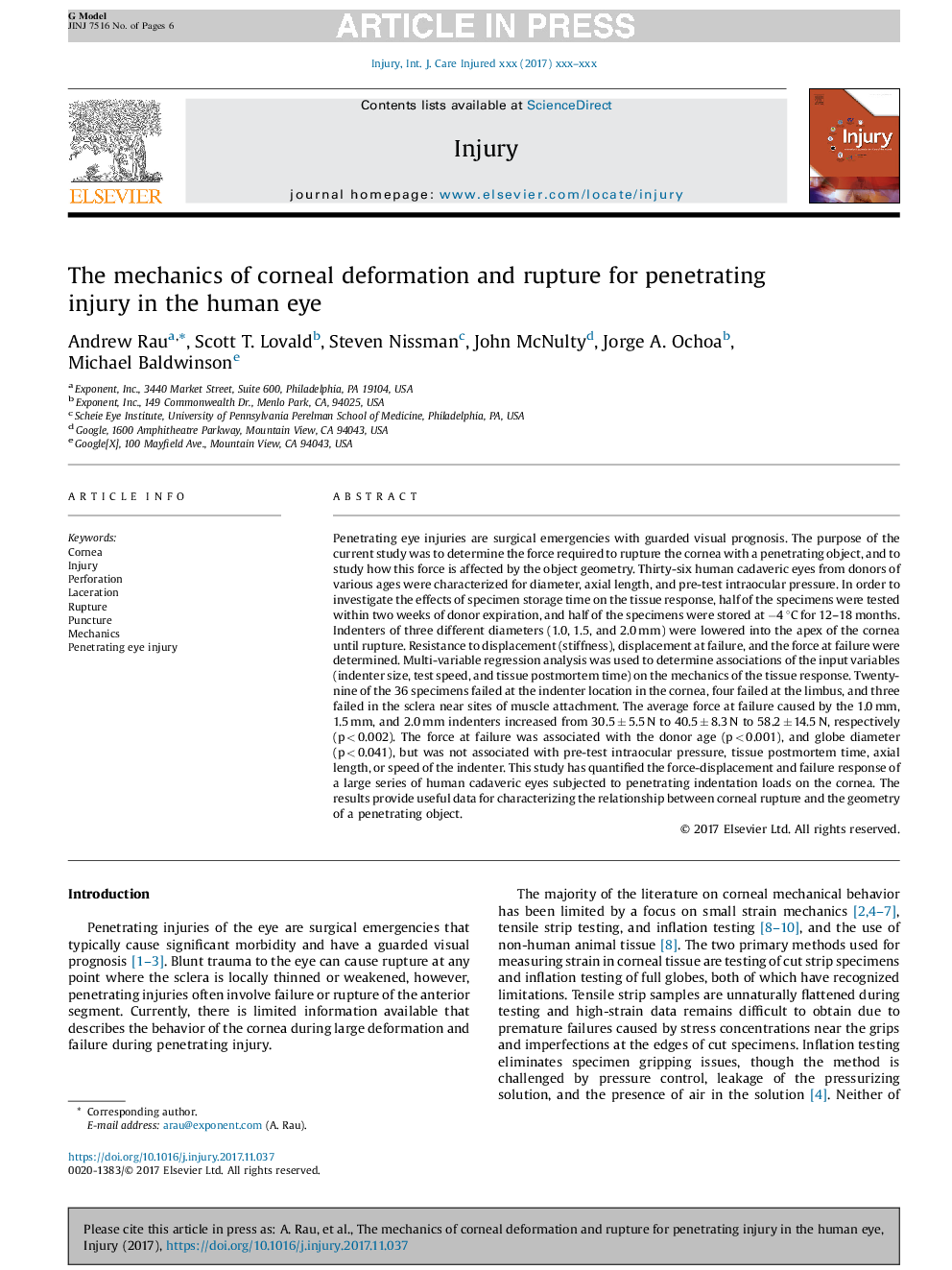| کد مقاله | کد نشریه | سال انتشار | مقاله انگلیسی | نسخه تمام متن |
|---|---|---|---|---|
| 8718795 | 1588884 | 2018 | 6 صفحه PDF | دانلود رایگان |
عنوان انگلیسی مقاله ISI
The mechanics of corneal deformation and rupture for penetrating injury in the human eye
ترجمه فارسی عنوان
مکانیک تغییر شکل و پارگی قرنیه به دلیل صدمۀ نافذ در چشم انسان
همین الان دانلود کنید
دانلود مقاله ISI انگلیسی
رایگان برای ایرانیان
کلمات کلیدی
قرنیه، صدمه، سوراخ شدگی، پارگی لاکریماسیون ، پارگی، سوراخ شدگی، مکانیک، جراحت نافذ چشم
فهرست مطالب مقاله
چکیده
کلمات کلیدی
مقدمه
مواد و روشها
نتایج
بحث
نتیجهگیری
کلمات کلیدی
مقدمه
مواد و روشها
نتایج
بحث
نتیجهگیری
ترجمه چکیده
صدمۀ نافذ چشمی، وضعیت اورژانس جراحی با پیشآگهی بصری غیرقابلپیشبینی است. هدف از انجام این مطالعه تعیین نیروی لازم برای ایجاد پارگی در قرنیه با یک جسم نافذ و بررسی چگونگی تأثیر هندسۀ جسم بر این نیرو بوده است. سیوشش چشم جسد انسان از اهداکنندگان در سنین مختلف ازنظر مشخصههای قطر، طول محوری و فشار داخل چشمی پیشآزمون مشخص گردید. بهمنظور بررسی اثر مدتزمان نگهداری نمونه بر پاسخ بافتی، نیمی از نمونهها طی دو هفته پس از مرگ اهداکننده مورد آزمایش قرار گرفتند و باقی نمونهها به مدت 12 تا 18 ماه در دمای منفی 4 درجه سانتیگراد نگهداری شدند. فروروندهها با سه قطر مختلف (1.0، 1.5 و 2.0 میلیمتر) تا زمان ایجاد پارگی، روی رأس قرنیه پایین آمدند. مقاومت در برابر جابجایی (سختی)، جابجایی در هنگام گسیختگی و نیرو در هنگام گسیختگی تعیین شد. برای مشخص نمودن ارتباط متغیرهای ورودی (اندازۀ فرورونده، سرعت آزمون و زمان پس از مرگ بافت) با مکانیک پاسخ بافتی از تحلیل رگرسیون چند متغیره استفاده شد. بیستونه نمونه از 36 نمونه در محل فرورونده در قرنیه، چهار نمونه در لیمبوس و سه نمونه در صلبیه نزدیک محلهای اتصال ماهیچه دچار گسیختگی شدند. میانگین نیروی هنگام گسیختگی ناشی از فروروندههای 1.0، 1.5 و 2.0 میلیمتری به ترتیب از 5.5±30.5 نیوتن به 8.3±40.5 نیوتن به 14.5±58.2 نیوتن افزایش یافت (0.002 > p). نیرو در هنگام گسیختگی با سن اهداکننده (0.001 < p) و قطر کره (0.041 < p) مرتبط بود، اما با فشار داخل چشمی پیشآزمون، زمان پس از مرگ بافت، طول محوری و یا سرعت فرورونده ارتباطی نداشت. مطالعۀ حاضر جابجایی نیرو و پاسخ گسیختگی تعداد زیادی چشم جسد انسان که در معرض بارگذاری فرورفتگیهای نافذ روی قرنیه قرارگرفتهاند را کمیت سنجی نموده است. نتیجۀ مطالعه دادههای مفیدی برای توصیف رابطۀ بین پارگی قرنیه و هندسۀ یک جسم نافذ ارائه میدهد.
موضوعات مرتبط
علوم پزشکی و سلامت
پزشکی و دندانپزشکی
طب اورژانس
چکیده انگلیسی
Penetrating eye injuries are surgical emergencies with guarded visual prognosis. The purpose of the current study was to determine the force required to rupture the cornea with a penetrating object, and to study how this force is affected by the object geometry. Thirty-six human cadaveric eyes from donors of various ages were characterized for diameter, axial length, and pre-test intraocular pressure. In order to investigate the effects of specimen storage time on the tissue response, half of the specimens were tested within two weeks of donor expiration, and half of the specimens were stored at â4 °C for 12-18 months. Indenters of three different diameters (1.0, 1.5, and 2.0 mm) were lowered into the apex of the cornea until rupture. Resistance to displacement (stiffness), displacement at failure, and the force at failure were determined. Multi-variable regression analysis was used to determine associations of the input variables (indenter size, test speed, and tissue postmortem time) on the mechanics of the tissue response. Twenty-nine of the 36 specimens failed at the indenter location in the cornea, four failed at the limbus, and three failed in the sclera near sites of muscle attachment. The average force at failure caused by the 1.0 mm, 1.5 mm, and 2.0 mm indenters increased from 30.5 ± 5.5 N to 40.5 ± 8.3 N to 58.2 ± 14.5 N, respectively (p < 0.002). The force at failure was associated with the donor age (p < 0.001), and globe diameter (p < 0.041), but was not associated with pre-test intraocular pressure, tissue postmortem time, axial length, or speed of the indenter. This study has quantified the force-displacement and failure response of a large series of human cadaveric eyes subjected to penetrating indentation loads on the cornea. The results provide useful data for characterizing the relationship between corneal rupture and the geometry of a penetrating object.
ناشر
Database: Elsevier - ScienceDirect (ساینس دایرکت)
Journal: Injury - Volume 49, Issue 2, February 2018, Pages 230-235
Journal: Injury - Volume 49, Issue 2, February 2018, Pages 230-235
نویسندگان
Andrew Rau, Scott T. Lovald, Steven Nissman, John McNulty, Jorge A. Ochoa, Michael Baldwinson,
